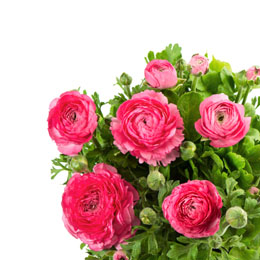Ranunculus flowering season is usually from January till May, though they can bloom for a month less or more. However, by following some plant maintenance instructions, one can extend their season. Here's how...

Ranunculus (pronounced as ran-un-kew-lus) comes in a variety of colors. Shades of orange, yellow, peach, pale pink, hot pink, red and white ranunculus flowers can be seen. The word ranunculus is derived from the Latin word 'rana' which means frog, this is so because these flowers grow in wet areas. Other names for ranunculus are buttercups and Persian buttercups. Bouquets of ranunculus look very beautiful, and hence these flowers are very popular as wedding flowers. During spring weddings, one can find fresh ranunculus flowers of various colors. Because, this is the blooming season for ranunculus.
Tips to Prolong the Blooming Season
- Keep watering these flowering plants carefully to prevent any root diseases, the soil should be maintained moist all the times but not wet.
- Trim out the deadheads from the stem. This leads to more fresh blooms, as the dead-heading spent flowers gives a message to the tuber to produce even more blooms.
- Provide a shade cover during the afternoon sun and heat, which will shorten the bloom time.
- You can consider planting them in an area that has good air circulation, to maintain the cooling effect.
- Provide a light fertilizer every week, that has high phosphorus amount. Dilute a liquid fertilizer with cool water, and apply it near the roots of the plan.
- Mulching can also be done using shredded bark and bean hulls.
Ranunculus Growing & Caring Tips
One can buy a bag of
20 tubers for a price of one dollar. Ranunculus bulbs are cheaper than other bulbs, and are easy to plant. They should be planted only 1-2 inches deep under the soil, and hence their plantation is not a lot of hard work. Ranunculus are tough and can sustain light frost, bright sun, and mild drought. While planting them, select a bed which has
well-drained soil. Mix peat moss, compost and ground bark to improve the soil's quality. On a sunny site, plant the bulbs 2 inches deep with their banana shaped tip pointing up. Water the plant bed well by soaking the area, the roots and sprouts will appear during autumn. Winter will bring taller growth, and eventually flowers will appear in spring.
During
spring time, feel free to cut the flowers to make bouquets. The trimming will encourage more blooms to grow, so snip the flowers off the plant whenever you feel like. After the flowering season is gone,
do not cut the foliage. The leaves will get nourishment from the sunlight, and provide them water regularly. After the summer, the leaves will become yellow and drop and the plant will move into dormancy;
avoid watering during this stage. The plants will again bloom in the spring season.
It is possible to use the tuberous roots of ranunculus plants for propagation. So, if you have a strong and large ranunculus plant then
simply lift and divide the roots after the flowering season has passed. Use a fork to gently lift the tuberous roots. You can keep the parts of root in pots which have compost containing soil. Then store them in a cold frame. Once the spring arrives, plant them out.
Facts About Ranunculus Flowers
Ranunculus flowers symbolize radiant charm, and hence a bouquet of ranunculus is used to convey a message 'that you are charming or attractive'. This flower is assumed for its alchemical properties, and are used to display stunning beauty near a welcoming glided statue at an entrance of an ancient city. Ranunculus plants need a lot of water, and one needs to always keep them as much hydrated as possible. The stem of this flowering plant is slender, and one needs to take good care of the stems too, along with the flowers. These flowers are a cost-effective option, as compared to the other multi-petaled flowers like garden and cabbage roses; a stem of ranunculus costs around USD 2.5.
So, keep in mind the above tips and enjoy the lovely blooms of ranunculus!






 Ranunculus (pronounced as ran-un-kew-lus) comes in a variety of colors. Shades of orange, yellow, peach, pale pink, hot pink, red and white ranunculus flowers can be seen. The word ranunculus is derived from the Latin word 'rana' which means frog, this is so because these flowers grow in wet areas. Other names for ranunculus are buttercups and Persian buttercups. Bouquets of ranunculus look very beautiful, and hence these flowers are very popular as wedding flowers. During spring weddings, one can find fresh ranunculus flowers of various colors. Because, this is the blooming season for ranunculus.
Ranunculus (pronounced as ran-un-kew-lus) comes in a variety of colors. Shades of orange, yellow, peach, pale pink, hot pink, red and white ranunculus flowers can be seen. The word ranunculus is derived from the Latin word 'rana' which means frog, this is so because these flowers grow in wet areas. Other names for ranunculus are buttercups and Persian buttercups. Bouquets of ranunculus look very beautiful, and hence these flowers are very popular as wedding flowers. During spring weddings, one can find fresh ranunculus flowers of various colors. Because, this is the blooming season for ranunculus.